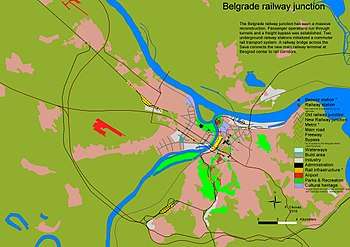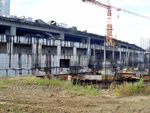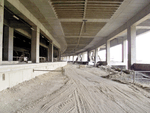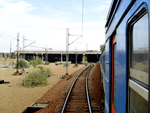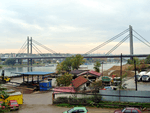Belgrade Centre railway station
The Belgrade Centre railway station (Serbian: Железничка станица Београд Центар, romanized: Železnička stanica Beograd Centar), colloquially known as Prokop (Serbian Cyrillic: Прокоп), is the new central railway station in Belgrade, the capital of Serbia. The station is located in the Belgrade municipality of Savski Venac. Although unfinished, it serves as de facto main railway station of the city, after replacing the old main station at the Belgrade Waterfront.[1]
Belgrade Centre railway station Prokop Железничка станица Београд Центар | |
|---|---|
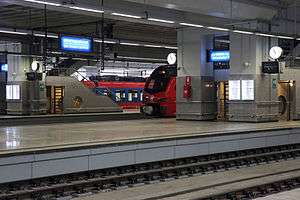 Belgrade Centre railway station | |
| Location | Prokupačka St. Savski Venac, Belgrade Serbia |
| Coordinates | 44°47′37″N 20°27′14″E |
| Owned by | Serbian Railways |
| Platforms | 5 operational (6 planned + 2 metro platforms planned) |
| Tracks | 8 operational (10 planned + 2 metro tracks planned) |
| Construction | |
| Structure type | At-grade |
| History | |
| Opened | 1974 (Partially) 10 December 2017 (Main national) 1 July 2018 (Central) |
| Location | |
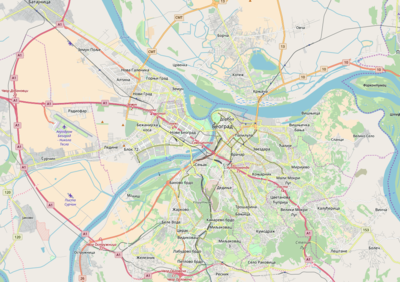 Belgrade Centre railway station Prokop Location within Belgrade | |
The unsuccessful, decades-long attempted construction of the new central railway station of Belgrade was hampered by a lack of funding to finish adjoining 14 km of tunnels, several railway bridges including the New Railroad Bridge across the Sava river, a new road network connecting to the city and technical installations. Due to the countless setbacks in the period of several decades, construction of the new station has been called Skadar na Bojani, after the folk epic poem The Building of Skadar, where the town of Skadar was unsuccessfully built for a long time.[2] The entire construction process has been described as infamous, where deadlines were continuously falling one after another.[3]
Belgrade Centre station was opened on 26 January 2016,[4] serving two daily trains to Novi Sad, as well as Belgrade commuter railways.[5] Following gradual re-routing, it gained its current role on 1 July 2018.
Construction
History
Beginning
The ill-fated construction of the new railway station, which was supposed to replace the Belgrade Main railway station in Savamala, was to last for decades. Originally, in the late 1960s, it was supposed to be constructed near the present interchange of Autokomanda, but the idea was suddenly dropped, and one of the major architectural authorities at the time, Branko Žeželj, picked Prokop instead, which ultimately left the Autokomanda interchange unfinished—the exit in the Niš direction was only finished in 2007. The idea was presented publicly in February 1970. It also included the removal of all tracks from the Savamala (Sava Amphitheatre) and of the Belgrade Main railway station, too, while the location along the river was to be turned into the vast green areas.[6] The Council for Urbanism drafted the projected construction of the new railway station in 1971. The project was monumental and expensive, without a precedent in Yugoslavia. It was envisioned to be "large enough for the entire 21st century" with 10,000 commuters per hour. Because of that, including the seemingly unrealistic deadline of only 18 months, the Council's session after which the plan was given the green light, was very turbulent and lasted for 7.5 hours. In 1974 the design project was finished and construction began on 8 October 1977.[7][8] The station building was planned to have a bird-shaped roof. The station was planned with 8 platforms and 11 tracks.[9]
Deadline for completion was 1 May 1979, but the rapidly deteriorating economic situation in Yugoslavia at the time slowed construction and the project was halted in 1980. In May 1984, the notion of abandoning the project altogether, due to high costs, was officially considered for the first time. Construction resumed in 1990 and in the next several years was stopped and restarted several times. The project itself was simplified. In 1996 a new contract was signed with the Energoprojekt company. The President of Serbia Slobodan Milošević and Prime Minister Mirko Marjanović officially opened the construction of the concrete roof slab on 7 July 1996, which was for the most part finished in 1999, but the building was halted again due to the NATO bombing of Serbia and lack of funds.[7][8][9]
Restart
In 2005 an international competition was held to find the strategic partner who would finish the station and acquire rights to build and sell commercial facilities. The Hungarian company TriGranit was chosen, but in 2008 TriGranit was dismissed and the contract with Energoprojekt from 1996 was reactivated. Energoprojekt came second on the public bidding but still was chosen. As the works were to last for 14 months, 2010 was set as the final deadline, but there was no progress due to the lack of funds. Also, this project excluded the construction of the commercial area.[9] In 2012, a €25.8 million loan was granted by the Kuwait Fund for Arab Economic Development, and on 3 December 2014 work was resumed, with the Energoprojekt as the lead company of the construction consortium, being chosen again after the bidding. The work was expected to be completed in 14 months,[7][8] and the station was indeed officially opened on 26 January 2016 by the prime minister Aleksandar Vučić. However, the new station was not used to capacity and was basically still just one of a dozen secondary stations in Belgrade.
On 10 December 2017 all but three lines of the domestic transport were transferred from the Main station to Prokop. International trains continued using the Main station, and that due to the fact that, by this time, Belgrade Centre is still not completed. In December 2017, the station had no station building or any commercial facilities, two tracks were still not finished as well as the roof above them, the road connections to the rest of the city are only half completed, etc. Ministry of construction estimated that, if the funds were granted, the entire work could be finished in two years.[10]
Central Station
An additional problem which appeared is that Prokop has no facilities for loading and unloading cars from the auto trains, nor was ever planned to have one. Still, in January 2018 it was announced that the old station will be completely closed for traffic on 1 July 2018, even though none of the projects needed for a complete removal of the railway traffic are finished. While Prokop is incomplete, a projected main goods station in Zemun is not being adapted while there are also no projects on the Belgrade railway beltway. A series of temporary solutions have to be applied, including a defunct and deteriorated Topčider railway station, which is revitalized and adapted for auto trains. The major flaw remains a bad public transportation connection (only one tram line, No. 3), so the railway company asked officially for this problem to be solved. It was also announced in January 2018 that the official deadline for the construction of the station building in Prokop is two years, however there were no funds for it at the time. A second part of the Kuwaiti loan (€50 million) is still not approved and the needed public procurements won't be finished till the end of 2018. The central freight station in Zemun also has a deadline of two years, but the works are scheduled to start at the end of 2018. This means that the planned Belgrade railway junction won't be finished before 2021, at best. However, minister for transportation Zorana Mihajlović gave conflicting deadlines in December 2017. She said that the station building in Prokop will be built from April 2018 to April 2019 and that freight station Zemun should be finished by the end of 2018.[11][12]
Only the access road from the direction of the Bulevar Kralja Aleksandra Karađorđevića was finished in 2018. The station still lacks a 9,000 m2 (97,000 sq ft) of roof and the platforms beneath it, the building itself and the access road to the highway. The bidding for the roof slab failed and it was estimated that addition €50 million were needed for the completion.[9] In June 2018 it was estimated that in the best case scenario Prokop will become a fully functional station, with all the necessary and supporting services, only by 2021.[13]
Additional 3,800 m2 (41,000 sq ft) of roof was finished in December 2018 after 8 months of works, so now some 40,000 m2 (430,000 sq ft) out of planned 45,000 m2 (480,000 sq ft) was completed. The authorities again refused to disclose the date of full completion of the entire station complex. It was evident at this point that works on station building will not start in 2018, missing tracks for two additional platforms haven't been laid nor anything has been done on Zemun freight station.[14]
Though itself inadequately equipped, the Novi Beograd railway station initially de facto took over the role of the main station after the closing of the old one, as it is better connected with other parts of the city and way more accessible than the Prokop. By early 2019 it came out as one of the busiest stations.[15] As for the Prokop itself, when the traffic was rerouted in July 2018, it was announced that the station will operate 195 lines: 16 international, 56 local and 123 communal BG Voz lines. By February 2019 only 60 lines remained operational: 1 international, 24 regional and 35 local.[16]
As it became apparent that the Kuwaiti loan will not be available, in July 2019 the government announced a public bidding for the partner who will build the station's main building, commercial facilities and parking lots. Even though the present project for the station was accepted by the government in 2015, the future partner will be allowed to present its own design.[2] Though the government claimed since 2016 that numerous domestic and foreign companies were interested, by October 2019 only one applied - Railway City Belgrade, Dutch-Bulgarian company recently registered in Serbia.[3] In April 2020 it was announced that the talks with the Railway City Belgrade are in the "final phase", but without any specifications on the price or timeline. It was stated, however, that the concrete roof slab will be finished first, then the urban project will be drafted, followed by the new re-parceling. That means the entire 2015 urban plan was scrapped, while the works on the station's building can't start before the second half of 2021 and will be finished in 2023 in the best case scenario.[17]
Controversies
In the late 1990s, instigated by first lady Mirjana Marković, an initiative was started to build a Chinese commercial centre in Prokop, which was to enhance the economic cooperation and trade between China and Serbia.[8]
Supervisor Dragan Dobrašinović, who reported to the Financial Board of the National Assembly of Serbia, said that procedures for the 2014 reconstruction were "distinctively political" due to the pushing of the Belgrade Waterfront project. He also pointed out that the projected price was inflated by over 5.5 million euros, as the estimate was 20.25 million and the loan was 25.8 million euros. The Assembly's Board accepted Dobrašinović's report, but dismissed him and no legal proceedings followed.[7]
When it was announced that the Kuwaitis would grant the loan, Serbian authorities published a computer model of what the future station building would look like. It turned out to be a picture of the Hong Kong's West Kowloon Terminus, set against Belgrade as a background. The 2009 project is the work of the Aedas company and architect Andrew Bromberg who personally reacted to the plagiarism.[18]
Criticism
The construction of the Belgrade Waterfront and track removal in Savamala and apparent pressure to finish the work before the expiration of the deadline, contributed to the hastily done job. Basically, no other facilities were built except for the tracks. The roof was unfinished and due to rain and wind the platforms on the periphery are covered in water. Access roads were not completed either and Prokop is generally badly connected with other parts of Belgrade.[19] Regarding how distant the station is from downtown, its official name, Belgrade Center, is often mocked and ignored by the citizens and passengers who almost without exception call it Prokop.[20]
Member of the Serbian Academy of Sciences and Arts and a public transportation expert, Vukan Vučić, labeled Prokop as the "most disastrous error of the Belgrade transportation". He asserted that Prokop, in functional terms, is not a station at all and that, though it has been named Belgrade Centre, is actually further from the city's centre than the old station was. He added that the location is a neglected, desperately bad choice and topographically inaccessible from all sides. As a result, commuters need almost 20 minutes to leave the station upon their arrival and have to travel for 3 to 4 km (1.9 to 2.5 mi) to downtown to reach other public transportation routes as Prokop itself is not interconnected. Another member of the Academy, transportation engineer Dušan Teodorović, also criticized the project.[21] As nothing of the planned infrastructure has been built – urbanization and development of the neighborhood, numerous commercial objects, hotels, excellent commuting connections, two metro lines, taxi station – Vučić maintains that the isolation of the location will directly bring to the further decrease in the number of railway passengers.[22]
Those who participated in the planning of the station maintain that Prokop was the best solution and that the problem is that other parts of the plan weren't carried out or have been dropped completely. They say that the idea was to have only through stations in the city and not a terminus station. Some of the missing infrastructure which they named, and which were considered megalomaniacal to begin with by the critics, include three additional railway stations (new or expanded: New Belgrade, Zemun, South), two additional bus stations (South, East) and lengthening and widening of the Deligradska Street from its current end at the highway, including the demolition of the urbanized hill of Maleško Brdo, east of Prokop.[23]
Despite numerous major drawbacks of the station, minister Mihajlović in July 2018 stated that the priority in Prokop was "elevators and escalators",[24] but none of the elevators were installed by December 2018.[14] Construction of two elevators began in February 2019 and they became operational in June 2019.[25]
Image gallery
|
References
- Polazak: Prokop postaje glavna stanice Beograda
- Dejan Aleksić, Daliborka Mučibabić (17 July 2019). Држава тражи партнера за завршетак Прокопа [State searching for partner to finish Prokop]. Politika (in Serbian). p. 15.
- Dejan Aleksić, Daliborka Mučibabić (28 December 2019). "Holandsko-bugarska kompanija potencijalni graditelj Prokopa" [Dutch-Bulgarian company potential constructor of Prokop]. Politika (in Serbian). p. 14.
- "Vucic opens Prokop railway station after 40 years". Tanjug. 26 January 2016.
- "Vučić otvorio "Prokop" posle 40 godina gradnje: Cela stanica gotova 2018". Blic. 26 January 2016.
- B.Gvozdenović, B.Trbojević (18 February 1970). Нова станица у "Прокопу" [New station in "Prokop"]. Politika (reprint on 18 February 2020 (in Serbian).
- Nikola Belić (11 February 2016). "Osam koloseka u Prokopu biće otvoreno u januaru iduće godine" (in Serbian). Politika. p. 17.
- Marko Lakić (17 October 2008). "Još jedan rok za Prokop". Politika (in Serbian). p. 13.
- Dejan Aleksić (8 July 2018). "Železnica u prestonici - Novi Beogradski čvor nije samo "Prokop"" [Railway in the capital - New Belgrade junction is not only Prokop]. Politika (in Serbian).
- Dejan Aleksić (9 December 2017). ""Prokop" postaje glavna stanica za domaće polaske" ["Prokop" becomes the main station for the domestic routes]. Politika (in Serbian). p. 15.
- Dejan Aleksić (16 January 2018). "Posle 134 godine bez vozova u Savskom amfiteatru" [No more trains in Sava amphitheater after 134 years]. Politika (in Serbian). pp. 01 & 16.
- Beta (11 January 2018). "Prokop nema prilaz za auto-voz, sređuje se stanica Topčider" [Prokop has no access for the auto train, Topčider station is being adapted] (in Serbian). N1.
- G.Vlaović (21 June 2018). "Građani će se zbog Arapa mučiti da dođu do voza" [Because of the Arabs, citizens will have hard time reaching the train] (in Serbian). Danas.
- Dejan Aleksić (21 December 2018). "За осам месеци изливено 3.808 квадрата плоче" [3.808 m3 of a concrete roof slab finished in 8 months]. Politika (in Serbian). p. 14.
- Dejan Aleksić (29 January 2019). "Stanica Novi Beograd preuzela ulogu glavne" [Station Novi Beograd took over the role of the main station]. Politika (in Serbian). p. 13.
- S.Dabić (6 February 2019). "Prazan Prokop: Kroz stanicu dnevno prođe samo jedan međunarodni voz" [Empty Prokop: Only one international train passes through the station] (in Serbian). B92, Blic.
- Daliborka Mučibabić, Dejan Aleksić (11 April 2020). Станична зграда на Прокопу најраније 2023. [Station's building in Prokop in 2023 at the earliest]. Politika (in Serbian). p. 16.
- Andrew Bromberg (22 February 2016). "Otkriven plagijat: Srpski Prokop već postoji u Hongkongu" (in Serbian). Newsweek Serbia.
- Momčilo Petrović (3 February 2016). "Vučićeva promaja: samo pola sata od otvaranja, Prokop je ponovo postao samo rupa u brdu" (in Serbian). Newsweek Serbia. Archived from the original on 21 April 2017. Retrieved 21 April 2017.
- Dejan Aleksić (23 February 2020). "Sastanak kod "Lole", na utakmicu u "Pionir"..." [Date at "Lola", to the ballgame in "Pionir"...]. Politika (in Serbian).
- A.Popović (18 April 2018). "Prokop najkatastrofalnija greška saobraćaja u Beogradu" [Prokop (is) the most disastrous error of the Belgrade transportation]. Danas (in Serbian).
- Dejan Aleksić, Daliborka Mučibabić (18 April 2018). "Plan za metro u interesu putnika, a ne investitora" [Plan for the metro (should be) in the interest of the passengers, not of the investors]. Politika (in Serbian). p. 14.
- A.Popović (24 April 2018). "Nezavršena infrastruktura baca senku na Prokop" [Incomplete infrastructure casts a shadow over Prokop] (in Serbian). Danas.
- Dejan Aleksić (4 July 2018). "Pruga u istoriju, opasne materije kroz tunele" [Railway into history, hazardous materials into tunnels]. Politika (in Serbian).
- Dejan Aleksić (20 June 2019). Од данас раде лифтови у "Прокопу" [Since today, elevators in "Prokop" are operational]. Politika (in Serbian). p. 14.
External links
| Wikimedia Commons has media related to Belgrade Centre railway station. |
- Clip of the planned railway hub with metro interchange
- Clip about the Belgrade railway hub and Beovoz commuter network
